A round up of the current and upcoming gallery exhibitions around the UK written by Martin Holman for Newlyn School of Art e-newsletter subscribers. We will be sending out a dedicated blog article in the next fortnight on our Year-long course end of year exhibitions taking place in June.
After Impressionism: Inventing Modern Art
NATIONAL GALLERY, LONDON 25 March to 13 August 2023
https://www.nationalgallery.org.uk/exhibitions/after-impressionism-inventing-modern-art
,.jpg)
Paul Gauguin, Vision of the Sermon (Jacob Wrestling with the Angel), 1888. Image: © National Galleries of Scotland, Edinburgh
'The world today doesn't make sense, so why should I paint pictures that do?' – Pablo Picasso
This impressive, eclectic exhibition – timed to mark the 50th anniversary of Picasso’s death – celebrates a period of artistic rebellion and innovation, when artists broke with established tradition and laid the foundation for modern art.
Focussing on the decades between 1880 and the outbreak of the First World War in 1914, this show particularly celebrates three giants of the era: Paul Cézanne, Vincent Van Gogh and Paul Gauguin, and traces the influences they had on their peers and on wider circles of artists across Europe.
From Cézanne’s Mont Sainte-Victoire paintings through to Picasso’s first foray into Cubism, it traces these artist’s fascinating dismantling of academic conventions, the liberation of art’s materiality and the artists’ questioning perception of the world.
You’ll find Matisse there, as well as Mondrian, Kandinsky, Klimt, Munch, Seurat, Signac and Rodin. Unfamiliar figures like Lovis Corinth also appear.
London Gallery Weekend
Central & West London Galleries Friday 2 June 10—8, Saturday 3 June 11—6, Sunday 4 June 11—5
https://londongalleryweekend.art/

During the first weekend of June, over 150 contemporary galleries will be coming together to offer exhibitions, late-night openings, performances, curated tours hosted by leading art world figures, and even a few joint gallery parties, all for free.
Each of the three days focuses on one geographical area: Central London on Friday, the South on Saturday and Sunday in the East End. In the centre, for instance, Hauser & Wirth will showcase new sculptures and paintings by Gary Simmons, Herald St will display new works by young British artist Cary Kwok and Jane Dickson will be hosted at Alison Jacques (recommended: see below).
Lucie Rie: The Adventure of Pottery
KETTLE’S YARD, CAMBRIDGE 4 March 2023 – 25 June 2023
https://www.kettlesyard.co.uk/events/lucie-rie-the-adventure-of-pottery/
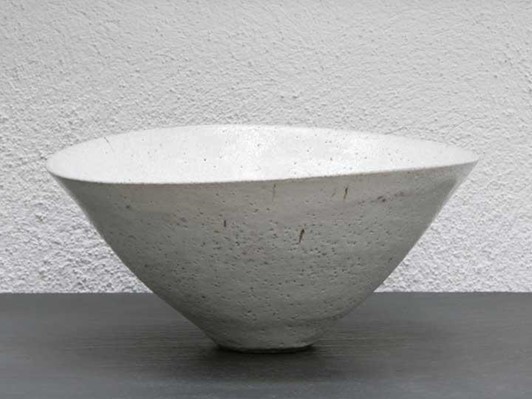
Lucie Rie, Conical bowl, 1971, stoneware with shiny white pitted and speckled glaze. Courtesy Kettle’s Yard, University of Cambridge
'To make pots is an adventure to me, every new work is a new beginning. Indeed I shall never cease to be a pupil'. – Lucie Rie
An inspiring exhibition celebrating Lucie Rie – one of the most significant potters of the twentieth century.
Born in Vienna, Rie’s early work from the 1920s and 30s are infused with innovation, characteristics that informed her creative practice throughout her life. In 1938, she emigrated to England to escape persecution, leaving behind her established and successful career. She arrived in London as something of a creative outsider. Her highly individual style of ceramics, influenced by Neoclassicism, Jugendstil, modernism and Japonism was at odds with the prevailing trends. Rie remained undaunted, and persisted with her pared down, essentialist approach, developing unique and complex slip-glaze surface that emerged directly from making rather than from rigorous pre-planning. Rie limited decoration on bowls and tall bottle forms to incised lines or subtle spirals. She changed the appearance of British ceramics.
The first show of her pottery in the UK in over 20 years, Lucie Rie: The Adventure in Pottery features more than 100 of Rie’s pieces. It takes place in the gallery attached to the converted barns that Jim and Helen Ede purchased in 1957 and converted it into one large, harmonious space that displays 20th century art and an array of curiosities and objects from around the world. The Edes loved Rie’s work and owned examples, including the white conical, stoneware bowl called The Wave, a title that derives from the undulating shape of the rim, a feature that became one of Rie’s trademarks.
Jane Dickson: Fist of Fury
ALISON JACQUES GALLERY 11 May to 24 June 2023
https://alisonjacques.com/exhibitions/jane-dickson-fist-of-fury
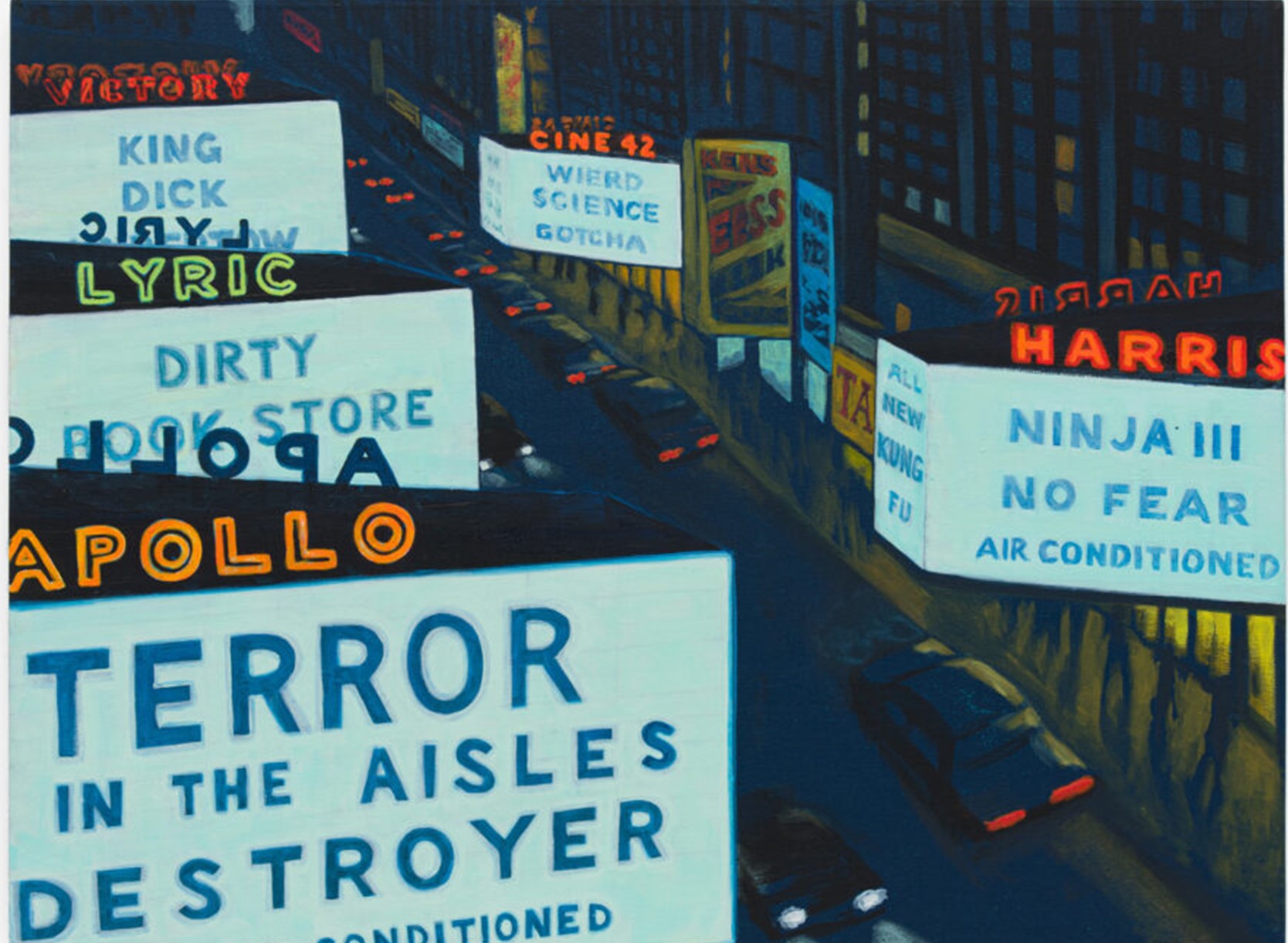
Jane Dickson, Terror Destroyer, 2020, Acrylic on linen, 91.4 x 121.9 cm © Jane Dickson. Courtesy Alison Jacques Gallery and the artist.
'I bought a little camera and carried it with me because I wasn’t about to sketch on the street. I would take mental notes for sketches, like some kid who was pickpocketing the theatre crowd'. – Jane Dickson
American artist Jane Dickson is not well known in this country, so this show is a great opportunity to become more familiar with her work. Dickson is a painter of American darkness – the New York City variety.
She first came to attention in the early 1980s for images of Times Square, where she had been working as an animator for Spectacolor (the first animated lightboard in the city), creating advertisements for leading brands and celebrity hangouts like Studio 54. Working with artists involved with street art, hip-hop, film and installation, she collaborated with Keith Haring and CRASH, and made mosaics on permanent display in the Times Square subway station.
Her other influences are more historical: Breugel, Hogarth, Hokusai, Edward Hopper (not surprisingly) and Goya – artists she describes as ‘dark observers of their society’. Using photography as her starting point, Dickson translates her snapshots into images painted on industrial materials: plastic, carpet, refuse bags, sandpaper, AstroTurf and mirrors, exploring their material qualities. Her nocturnal paintings depict peep shows, sleazy hotels and porn shops - the exhibitionism that defined the city’s downtown cultural scene before Manhattan was ‘cleaned up’ to make the streets safer for commerce, pedestrians and tourists, perhaps at the expense of the crowds flocking to the city for fun and escape.
Betty Woodman and George Woodman
Charleston, Firle, East Sussex, 25 March to 10 September
https://www.charleston.org.uk/exhibition/betty-woodman-and-george-woodman/

Betty Woodman, Aztec Vase and Carpet: April 2016, 2016. Courtesy of Woodman Family Foundation © Woodman Family Foundation/DACS London
'Marrying George, and my life with another artist, has been very, very, very important. We have a very vital exchange of ideas – probably every other day or something. We’re in each other’s studios and talking about work'. – Betty Woodman
The first in the UK to show both artists together, this exhibition celebrates the work of ground-breaking American ceramic artist and sculptor Betty Woodman (1930–2018) and painter and photographer George Woodman (1932–2017).
American sculptor Betty Woodman (1920-2018) was primarily a sculptor in ceramic, taking inspiration from Etruscan pots. George Woodman (1932-2016) is mostly remembered as a painter; initially abstract, his images later drew on Italian landscapes and mosaics.
Betty Woodman remains the better known and this show is a rare chance to see her work. She came from an era when women were not taken seriously as artists or academics, yet she spent 40 years as a teacher and is internationally recognised as one of the most important ceramic sculptors of our time.
In the 1970s she abandoned the functional approach to ceramics and began producing colourful, witty objects with inventive shapes. Experience of travelling and visiting museums, and living in Italy is apparent in scenes inspired by the Renaissance scenes or landscape forms with which she patterned the surfaces. In Antella, a village near Florence, Betty set up a studio and began experimenting with earthenware and glazes. Described by George as an ‘artist residency for two’, art, life and food merged. Being a good cook, she noted, made her a better artist. So the show fits well into the Charleston atmosphere redolent of Bloomsbury artists Vanessa Bell and Duncan Grant, where the dining table and conversations around it were as important to the ethos as any work produced in the studio.
Also showing at this gallery is Hylton Nel, the South African ceramicist and conceptual artist, who first began experimenting with ceramics in the 1960s. Over the course of 50 years, he has created an individual visual language, using his personal life experiences, his pets and global politics as his subject matter.
The Brown Collection
1 Bentinck Mews, London W1U 2AF Until 15 July 2023
https://glenn-brown.co.uk/the-brown-collection/
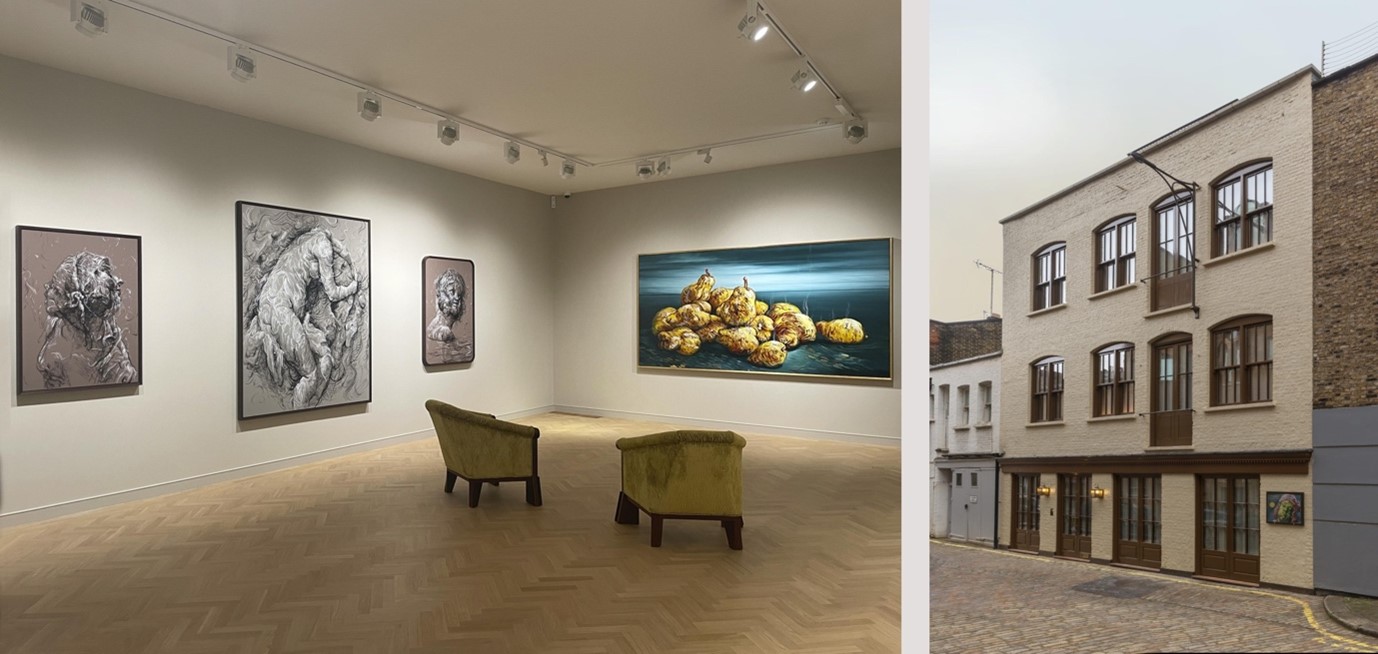
Interior and exterior views of The Brown Collection. Courtesy Glenn Brown/The Brown Collection
'I always refer to them as my abstract paintings. The abstracts are not really abstracts, though. In fact, there are things going on in there, but often it won’t be obvious what you’re looking at'. – Glenn Brown
British artist Glenn Brown has had a critically and commercially successful career on both sides of the Atlantic. The Brown Collection in Marylebone now houses his archive and exhibitions of his paintings, drawings and sculptures (which are more like 3D paintings in oil). The plan is to then show other artists – friends, inspirations and work – selected in dialogue with his own.
Brown’s work reflects a personal engagement with art history. Old Master become his launchpad for an entirely unique interpretation of Fragonard, Appel, Dalí, Auerbach or whoever’s work he is examining – and that includes sci-fi illustration. The painting’s materiality comes under particular scrutiny, above all, the rhythm of brushstrokes and density of surface. Technique fascinates him. His canvases present flat, smooth finishes that allude to an image reproduced in a book or magazine. Other manipulations and distortions take place too, which can suggest a satirical response to a Rembrandt, for instance, or a fleshy de Kooning. ‘I do use computers and forms of image-making other than painting,’ he says. ‘The computer is probably the best example of something that is there to challenge painting… the whole thing of should I paint or not, is painting dead? – of course it’s not… I love Photoshop and all of the possibilities of manipulation that it gives you to play with. But the final product from the computer is always very lacklustre.’
Colour is light on fire: Sam Francis Works on Paper
Omar Tiroche Gallery, London 28 February to 2 June 2023
https://omertiroche.com/exhibitions/66-current-colour-is-light-on-fire-sam/
'Painting is about the beauty of space and the power of containment'. Sam Francis

Sam Francis, To Hölderlin,1952, watercolour on paper, 49.8 x 65 cm. Courtesy Omer Tiroche Gallery. © the artist’s estate and representatives
Born 100 years ago, American abstract expressionist painter Sam Francis could paint on a monumental scale, and is credited with creating the world’s biggest painting on canvas and the largest-ever flatbed printing press. This small exhibition, however, focuses more on his works on paper. It offers a chance to come into contact with the vivid colour and emotional intensity that characterised his approach.
Drawing much of his inspiration from techniques he observed in Europe and Japan, he has been described as the ‘most sensuous and sensitive painter of his generation’ and his intention could be said to have been to make his paintings felt as much as seen.
Francis’ entry into the art world was somewhat unusual. He had wanted to be a reconnaissance airman but an accident in training left him in traction for several years during World War II. Francis took up painting to pass the time and was visited in his San Francisco hospital by the artist David Park who quickly became a mentor. Then Francis had a waking vision of ‘a great orb of light like an enormous electric current’ that entered his body (he had already read theories of mystical inner space, higher dimensions and cosmic consciousness). Visions of light and space, appearing in the mind’s eye, became, in essence, the subject and theme of his art for the next four decades.
He went to Paris in 1950, enrolling at the Atelier Fernand Léger and became fascinated by Monet’s late works. He encountered Sartre and Giacometti, and became lifelong friends with expatriate American abstractionist Joan Mitchell. His first Paris gallery show was a triumph. Francis travelled the globe, setting up studios in city after city. Some of his major canvases of the time were painted in multiple locations. A student of Zen Buddhism, he lived with the Japanese painter Toshimitsu Imai, wore a Japanese robe, and made numerous trips to Japan, eventually marrying his Japanese wife. Traditional Japanese aesthetics and Zen ink paintings strongly informed Francis’s increasingly open and ‘empty’ canvases.
Sonia Boyce: Feeling Her Way
TURNER CONTEMPORARY, MARGATE 4 FEBRUARY – 8 MAY
https://turnercontemporary.org/whats-on/sonia-boyce-feeling-her-way/

Sonia Boyce's installation at Venice, featuring singers Errollyn Wallen, Tanita Tikaram, Poppy Ajudha and Jacqui Dankworth. Photo: Cristiano Corte/British Council. All rights reserved.
In April last year Sonia Boyce won the Golden Lion at the Venice Biennale for the best exhibition in the art world’s leading art jamboree. Selected by a five-person international jury, Boyce’s show was a personal archive of sound and image, and an affirmation of the human spirit. It occupied the British pavilion, a late nineteenth-century building in neoclassical style, located between the pavilions of France and Germany. Now it is about to be recreated in a very different environment – the opaque-glass geometry of the Turner Contemporary in Margate.
Step inside and some of the five galleries resembled a (admittedly huge) teenager’s bedroom with the covers of favourite bands and singers decorating the walls, with electric lighting reflecting off CDs and other shiny surfaces. The experience of passing from room to room was uplifting and moving, accompanied by the voices of female Black British vocalists, performing on separate screens, sometimes improvised and often soulful.
The installation also evoked sensations of vulnerability; with the jagged edges of discordant wallpaper designs pointing straight at you. These same shapes also recall the textured surfaces of recording studios, an image affirmed by videos of the singers whose music carried through the pavilion. Photographs picked out the paraphernalia of the studio, too, to cement the idea of creativity and individuality. Unmissable.
Balthus: Under the Surface
Luxembourg & Co, London 3 March - 4 June 2023
https://luxembourgco.com/exhibitions/78/works/
'God knows how happy I would be if I could remain a child forever'. - Balthus

Installation view of Balthus: Under the Surface at Luxembourg + Co., London. Photo by Damian Griffiths.
For more than six decades, until his death, in 2001, at the age of ninety-two, Balthus depicted young girls in gamy poses, attributing any perceived eroticism to the viewers’ unclean minds. His other perennial subject was the cat, his totem animal. Both are subjected to his superb technique – and that male gaze, which can trouble even the purest spectator.
Balthus claimed that there was a quality of sacredness to his images, but others would disagree. His work
has never ceased to provoke; with the press in turns fascinated and outraged. This is the first substantial show in the UK since his 1968 retrospective at the Tate.
Today, his choice of subject is even more challenging, which is maybe why this show chooses to promote his particular technique of painting, especially his use of underpainting in cool tones of yellow, green and orange which mutes depth in his paintings. This technique, however, has the effect of bringing his themes directly to the fore.
Balthus was self-taught, learning from copying, especially his two artistic muses, Piero della Francesca and Gustave Courbet. While many artists were exploring the wider shores of modernism, Balthus was staying firmly with the figure, and modernists loved him, especially the Surrealists. It is a style that appears outside of historical time. In fact, his simple figures and bourgeois settings depicted with extreme, even enervating detail exist in a sequestered moment outside reality – at least, one would hope so.
Big Women
FIRST SITE, COLCHESTER 11 FEBRUARY – 18 JUNE
https://firstsite.uk/event/big-women/

 Sonia Coode-Adams, She Forgot, 1984.jpg)
(From left) Sonia Coode-Adams, She Forgot, 1984. Image: © Sonia Coode-Adams MBE; Georgina Starr, Head-standing, 2013. Image © Georgina Starr.
Curated by one of Britain’s most significant contemporary artists – Sarah Lucas – and featuring the work of over twenty high-profile female artists, the Big Women exhibition celebrates and examines the role women play in the creative world, and reflects on the challenges they have faced in recent decades which led some to give up as professional artists.
The theme ‘Big’ appears physically in some works – there’s a giant Claudia Schiffer on a pedestal in Gillian Wearing’s performance-sculpture-photograph, Claudia and Me: the artist looks up at the 1990s supermodel in awe. Renata Adela’s striking fabric sculpture, Origins of the World – We Are All Space Sailors, is based on medieval and early 18th-century gynaecological models; its title alludes to the painting by Gustave Courbet in the Musée d’Orsay.
The media used ranges from sculpture, painting and film to fashion, and the artists include Renata Adela, Erica Åkerlund, Fiona Banner aka The Vanity Press, Kate Boxer, Yoko Brown, Angela Bulloch, Phillippa Clayden, Sonia Coode-Adams, Vanessa Fristedt, Maggi Hambling, Pam Hogg, Rachel Howard, Merilyn Humphreys, Patricia Jordan, Princess Julia, Abigail Lane, Tory Lawrence, Millie Laws, Polly Morgan, Clare Palmier, Georgina Starr, Milly Thompson, Gillian Wearing, Sue Webster, and Lucas herself.
David Batchelor: I-Cons and Ex-cons
KESTLE BARTON, MANACCAN, HELSTON 25 MARCH - 11 JUNE
http://www.kestlebarton.co.uk/arts-and-events/david-batchelor-i-cons-and-ex-cons/

David Batchelor, Inter-Concreto 08, 2019, found painted timber, plexiglass and concrete, 1050 x 610 x 60 mm. © The artist. Courtesy the artist and Kestle Barton.
In 2000, arch-colourist Batchelor published a very entertaining and perceptive book called ‘Chromophobia’. He made up this word to describe a ‘fear of corruption by colour’ in western high culture that he believed had existed since at least the time of the Ancient Greeks: seriousness, the condition implied, is black-and-white, and meaning comes only in shades of grey.
One example of chromophobia in practice was the French eighteenth-century commentator Charles Blanc who thought of colour in art as something not to be totally relied upon. Blanc argued that while colour is essential, its place belonged behind the formal characteristics of composition, chiaroscuro and drawing. Batchelor’s book looks at what caused chromophobia and then picks out writers and artists who have been prepared to look at colour as a positive value.
Bachelor’s own work – whether sculpture, paint, print and other media – is awash with colour. This show at Kestle Barton brings together objects made with glass fragments, plastic off-cuts, paint tin lids, studio detritus and found objects of one kind or another and set into a simple rectangular concrete base. There is a strong improvised and, even, impermanent feel about the work that challenges the notion that artworks, once delivered into public space, must last forever. And yet, no doubt these will, too, since Batchelor’s output is eagerly collected.
The gallery explains that ‘the title I-Cons and Ex-Cons refers to studio shorthand for the larger and more recent works in a series: the Inter-Concretos and the Extra-Concretos… In addition, a new work made from hundreds of off-cuts from earlier Perspex sculptures but without a concrete base – a Non-Con – will be shown in front of one of the gallery windows, so that the coloured fragments are illuminated from behind and glow like an improvised stained glass window.’ Light, either natural or electric, is a regular component in his celebration of colour.
The Subversive Landscape
THE GALLERY, TREMENHEERE SCULPTURE GARDENS, GULVAL, 28 APRIL – 28 MAY
https://www.tremenheere.co.uk/
,.jpg)
Amikam Toren, Armchair Painting - Untitled (to be honest with you), found painting, stencil. © The artist. Courtesy the artist.
What happens when artists take a fresh look at a cherished tradition? The landscape, for instance. The English have a particular attachment to their ‘green and pleasant land’. Asked to explain what is special about it, landscape, art often provides the image - the music of Ralph Vaughan Williams, perhaps, or poetry by William Wordsworth. Or, maybe most often of all, the paintings of John Constable. He captured the radiance of a summer’s day or the drama of a big, lowering, East Anglian sky. ‘Natural beauty’ is the key ingredient.
This exhibition, brought together by painter Hugh Mendes, challenges that conformity of outlook. These works by twenty three contemporary artists in mid-career with international reputations (including four who collaborate professionally as couples) take an independent view of the landscape. All have created some unexpected viewpoints.
The artists are Fiona Banner, Michael Landy, James Turrell, Amikam Toren, Gordon Cheung, Alistair and Fleur Mackie, Rob and Nicky Carter, Robin Mason, Alex Gene Morrison, Kiera Bennett, Andrew Grassie, Reece Jones, Adam Dix, Hugh Mendes, Lucy Willow, Lee Maelzer, Roger Thorpe, Jesse Leroy Smith, Kirsty Harris, Dan Hays and Liane Lang.
We are floating in space
NEWLYN ART GALLERY & THE EXCHANGE 11 FEBRUARY — 3 JUNE 2023
https://newlynartgallery.co.uk/activities/we-are-floating-in-space/
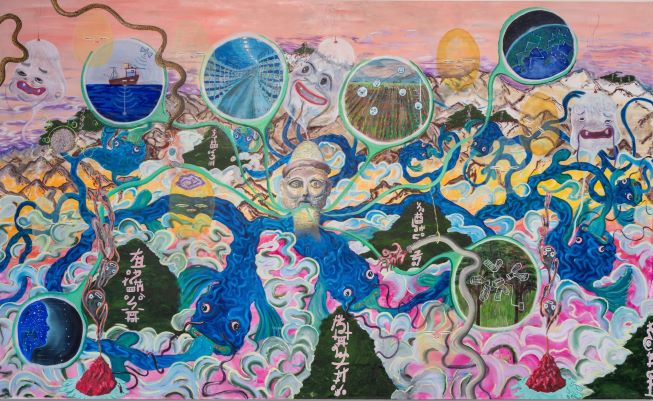
Huhtamaki Wab, An earth-wide network of connections or the 12,000th year death trip, god trip, making perfect conditions for a zoo, 2022, mixed media on canvas
This first exhibition since the two galleries emerged from almost three years of close collaboration with the Arts Council Collection, marks the return to independent programme making at the venue. This offering has over 20 artists from Cornwall and Devon in the ‘main’ show plus almost as many in a connected ‘show within a show’ at the Newlyn space. Coastline is the general theme, with the selected participants at different stages in their art careers.
According to the gallery, the show ‘looks beyond the tradition of seascapes to showcase artists who use the coast to address themes within their contemporary art practice.’ Two artists particularly stand out here. At the Exchange, Naomi Frears’ film Men Falling poetically juxtaposes the artist’s memory of her father’s death with the view from her Porthmeor studio of the ways in which male surfers come off their boards at the end of a ride. (Originally a two-screen presentation at Exeter Phoenix last year, it is here reduced to one screen, which is a pity.)
At Newlyn, Huhtamaki Wab‘s single, large-scale canvas mixes humans and the spirit world in landscapes where shapes and colours seem to relate both to his rural Devon surroundings of moors and rivers and to the animist traditions of his native Japan. Another feature is his own life experience of mental illness, recovery and spells of addiction. Add in elements from Japanese folklore and manga, and the paintings are ecstatic and unsettling, and certainly memorable. Wab also showed recently at Exeter Phoenix.
Giorgio Morandi: Masterpieces from the Magnani-Rocca Foundation
ESTORICK COLLECTION OF MODERN ITALIAN ART, LONDON 6 JANUARY - 28 MAY
‘I’m a painter of the kind of... composition that communicates a sense of tranquillity and privacy, moods which I have always valued above all.’ — Giorgio Morandi
, 1953.jpg)
Giorgio Morandi, Still Life (detail), 1953, Fondazione Magnani-Rocca. © DACS 2023
Giorgio Morandi (1890-1964) is most associated with still-life compositions featuring a familiar cast of objects – bottles, vases and jugs on a table. He also painted landscapes and, occasionally, figures. From the 1920s until the early ‘60s, Morandi’s paintings show remarkable consistency. With sombre colours (greys, browns and chalky whites) he was able to transform a group of everyday, domestic vessels into a composition that looks timeless and that projects a sense of permanence. 'It takes me weeks to make up my mind which group of bottles go well with a particular tablecloth,’ he once said. ‘And yet still I often go wrong with the spaces. Perhaps I work too fast.’ Superficially, the arrangements may all look very similar. But they are full of subtle shifts and inflections, dependent on precisely which objects are placed where, in what combination and under what sort of light. His preparation was painstaking and sometimes included grinding his own pigment. He was also fond of coating his repertoire of inanimate models in paint and allowing dust to accumulate on them. Morandi’s practice was focused on repetition, small gestures and silent perfection.
The works in this exhibition come from a single Italian collection, formed mostly after WW2 and spans Morandi’s entire career. The 50 works include paintings, drawings, watercolours and a large number of the artist’s etchings. One of the true masters of 20th-century figurative painting.
Action, Gesture, Paint: Women Artists and Global Abstraction 1940-70
WHITECHAPEL GALLERY, LONDON 9 FEBRUARY – 7 MAY
Wook-kyung Choi, Untitled (detail), 1960s, acrylic on canvas, 101 x 86 cm © Wook-kyung Choi Estate and courtesy to Arte Collectum
This is an important show – as is any serious, well-researched project which accords proper status to women artists whose importance was, and still is, too easily and very often undervalued by the male establishment.
With more than 150 artists, the selection suggests the scale of neglect during its 30-year span. Some women even resorted to using men’s names to overcome the prejudice: Corinne West painted as ‘Michael West’; ‘George Hartigan’ is now restored to history as Grace Hartigan. The New York school of 1940s and 50s dominates, but there are also on artists from Europe, Latin America, China, Japan, Iran and elsewhere. The drawback, however, is that having so many women means that most are represented by one work only.
Recognition for abstract-expressionist pioneers such as Helen Frankenthaler and Joan Mitchell, are shown here with other luminaries such as Lee Krasner, Elaine de Kooning and Grace Hartigan. Less familiar names shine out, too: Janet Sobel’s tangles of enamel on canvas were seen by Jackson Pollock and must have exerted an influence on his move into drip painting. Peruvian painter Gloria Gómez-Sánchez’s dense works incorporate detritus. Italians Bice Lazzari and Carol Rama, while not exactly abstract, delve into the psyche and emerge with paintings motivated by dream, thought and anger.
Tai Shan Schierenberg: Headspace
FLOWERS 82 KINGSLAND RD LONDON E2 8DP 10 MARCH - 6 MAY
https://www.flowersgallery.com/exhibitions/558-tai-shan-schierenberg-headspace/

Tai Shan Schierenberg, Self-portrait as Janus, 2008, oil on canvas 183 x 214 cm (72 1/4 x 84 1/4 in). © The artist. Courtesy Flowers
Schierenberg describes his work as lying ‘between different modes of reproducing reality’. The reality is there: his portraits are executed on a gigantic scale. As a result, the viewer is brought close to how the artist has translated his observations into an image.
A quality of his work that has been present and evolving since he first came to public attention at the end of the 1980s is the structural strength and subtlety of his compositions. There is a sensation of shifting ground, and it unites his approach to portraiture with how he tackles landscape, his other main theme. He feels his way into the subject with insight that goes beyond the visual. Recent portraits bring out that ‘psychological’ dimension, depicting himself so that he can suggest the multifaceted nature he perceives of his own personality.
SOUTINE | KOSSOFF
HASTINGS CONTEMPORARY 1 APRIL – 24 SEPTEMBER
https://www.hastingscontemporary.org/exhibition/soutine-kossoff/
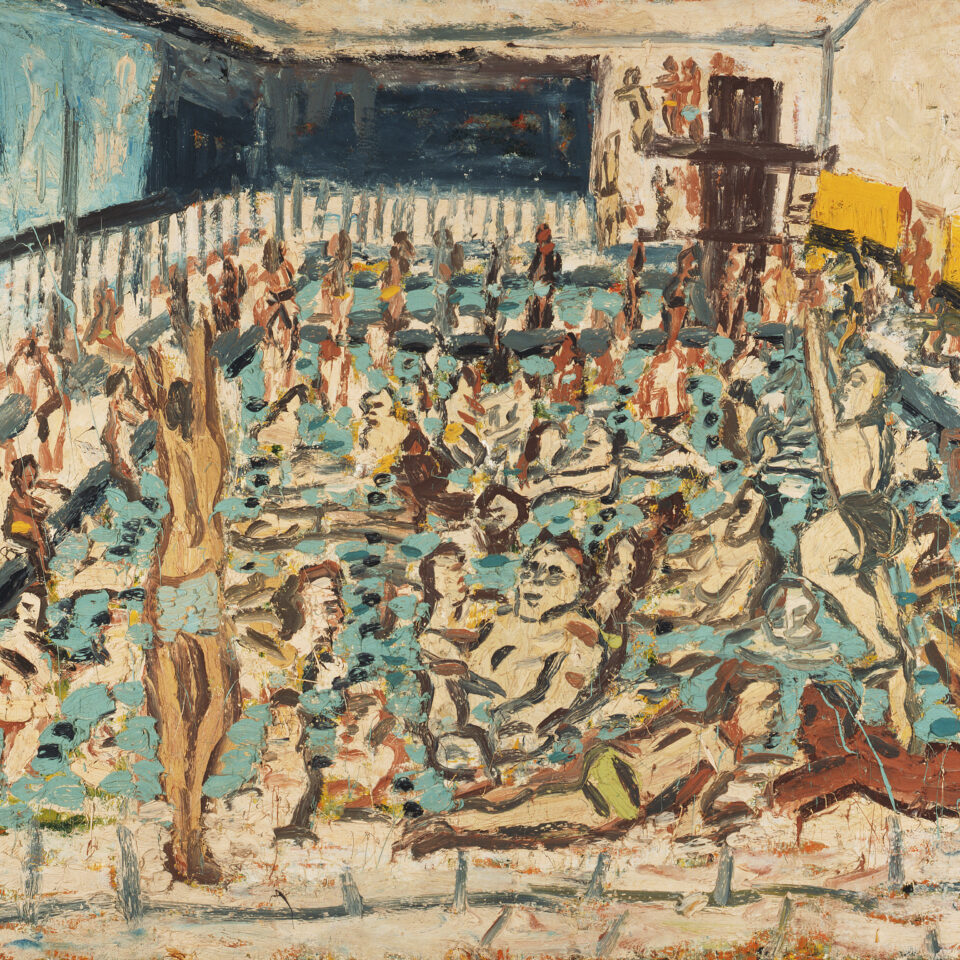
Leon Kossoff, Children’s Swimming Pool Autumn Afternoon, 1971. ©Tate
Any opportunity to see the work of Chaim Soutine (1894-1943) should be taken. Writing about the Russian, Dutch-born American abstract expressionist Willem de Kooning observed that there is ‘a certain fleshiness in his work’. In Soutine’s paintings, whether of people or landscapes, the paint pulsates like a living organism. Art historian Thomas Hess described a Soutine landscape as ‘the personal sensation of terror, violence, and paint’. If paint was invented to articulate flesh, Soutine was the artist who proved it.
When it comes to rivalling Soutine’s anxious, self-dramatising spirit, British painter Leon Kossoff (1926–2019) came extremely close. Kossoff, along with Francis Bacon, Lucian Freud and Frank Auerbach, epitomised the post-war British figurative tradition. His subjects were mostly family members and close friends. His paintings are powerful evocations of human presence, manifested in thickly layered, almost sculptural surfaces. This show represents an unprecedented chance of seeing their works together.
Exhibition round up by Martin Holman exclusively for Newlyn School of Art.
Martin Holman is a British art historian and writer on modern and contemporary visual art. He has a special interest in post-war Italian art and has been closely involved with exhibitions in Britain and Italy. His writing has appeared in the exhibition catalogues of public and private galleries, such as Camden Arts Centre, Haunch of Venison, South Bank Centre and Newlyn Art Gallery, and in newspapers and magazines, among them Art Monthly, Art Review, Burlington Magazine, Daily Telegraph, Frieze, The Guardian, Sculpture, The Times Higher Education Supplement and The Tablet. He lives in Penzance.